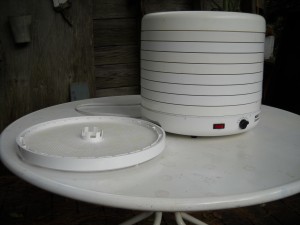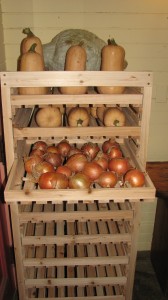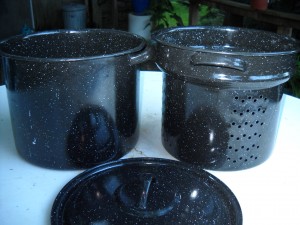Saving the Harvest
Tomatoes are an important part of my diet. I cook with them year round, and eat them more than once every day in season. My grandmother used to can them, and I still do on occasion, but the easiest thing to do with them is to freeze them whole. No blanching required. Just put clean, dry tomatoes in gallon zipper bags and freeze. Then, when you need tomatoes to cook with, take out a few and run them under hot water in the kitchen sink. Rub and the skins come off. Allow them to sit for a few minutes and they soften enough to chop and use.
I do make tomato sauce, but generally freeze it instead of canning it. I core the tomatoes and squeeze out some of the seeds and water, then puree them in the Cuisinart. I cook the tomatoes with onions, garlic, basil leaves, fennel seed, salt, pepper and whatever other spices appeal to me the day I make it. Sometimes I cheat and stretch my tomatoes by adding pureed zucchini to the sauce. The trick is to cook it enough so that the sauce is rich and thick. A little sugar (or maple syrup) is sometimes needed if the tomatoes are not dead ripe.
I also make tomato paste by cooking down pureed tomatoes until I can stand up a spoon in the mixture. I freeze the paste in ice cube trays, and then transfer it to Ziplock bags.
I dry tomatoes in a dehydrator, making little nuggets of pure tomato flavor for use in winter stews. Although you can use any size tomato, I generally just dry cherry tomatoes. I cut them in half and place on a try, cut side up. It takes about 24 hours to fully dehydrate a batch of cherry tomatoes – but I get about 75 of them on each tray and dry 6 trays or more each batch. Afterwards I put them in zipper bags and store in my freezer. I have plenty of freezer space, but if you don’t, they will store well in the fridge or even in the pantry. I also dry apples, pears and hot peppers most years. I grind my hot peppers in a coffee grinder after they are dry enough to be brittle. Making pepper powder allows me to add just the right amount of zing to a sauce.
My potato harvest was smaller this year than I would have liked, but I have enough for a few months. Potatoes store best between 33 and 50 degrees, with high humidity. An attached garage, bulkhead or unheated mudroom might have the proper temperature. Mice love them, so store them in plastic buckets or storage bins covered with hardware cloth (quarter-inch mesh screening) to keep mice out while allowing good air circulation.
Carrots, beets, rutabagas and celery root (celeriac) store well under the same conditions as potatoes: high humidity and cool temps. All root crops can be stored in the fridge (I keep a spare fridge in the basement), but tend to dry out unless in a drawer. You can leave root crops in the ground until it gets cold outside – although rodents may nibble on them. So if you leave root crops in the ground, check to make sure they are not being eaten.
Carrots store well in the ground. Just cover them with a layer of hay or straw , and then a layer fall leaves. Be sure to place a tall stake in the ground at each end of the row so that you can find the carrots even if we get 3 feet of snow. I’ve stored carrots that way, but found that in years of little snow the ground freezes, making digging difficult. Still, cold temperatures make carrots sweeter. I leave my parsnips in the ground and eat them in the early spring.
Cool dry storage is appropriate for winter squash, onions and garlic. Fifty degrees is about right, with low humidity. An upstairs bedroom with the heat turned off is usually good. I have an “orchard rack” from Gardeners Supply that works very well for storing those items. It is made of wood, with slats to allow good air circulation. It is always good to cure or dry onions and winter squash a bit before you put them in their final resting place. I spread them out on the deck in the shade, where they only get morning sun, but get good breezes. That allows them to lose a little water and to harden up a little on the outside.
Freezing veggies is one of the best ways of keeping them. Leafy greens, broccoli, Brussels sprouts, beans and summer squash need to be blanched. That means dropping them into boiling water just long enough to kill the aging enzymes that make them tough and tasteless. Sixty seconds is enough for most things – or until the color changes. Don’t blanch so long your veggies are cooked or mushy. Drop them into a sink of cold water to stop the cooking process as soon as you take them off the stove. I recommend investing in a blanching pot, which has an inner pot with holes, allowing you drain out the water as you lift them out of the bath.
Once your veggies are cool, spin them dry in a salad spinner and then pat dry with cloth towels. Put them in freezer-grade Ziplock bags, and suck the air out with a straw before closing the zipper all the way. No need to blanch tomatoes, leeks, berries or peppers.
I get great satisfaction from eating my own homegrown food. It takes work at this season, but for me it’s worth it.
A correction: A helpful reader let me know that the moth of the hornworm is not the hummingbird moth. Hornworm moths are as large as hummingbirds, but look different and have different habits. So don’t harm those hummingbird moths!
Henry Homeyer is the author of 4 gardening books. His e-mail is henry.homeyer@comcast.net and his web site is www.Gardening-Guy. com.





